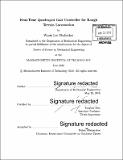Real-time quadruped gait controller for rough terrain locomotion
Author(s)
Ubellacker, Wyatt Lee
DownloadFull printable version (5.525Mb)
Other Contributors
Massachusetts Institute of Technology. Department of Mechanical Engineering.
Advisor
Sangbae Kim.
Terms of use
Metadata
Show full item recordAbstract
In disaster situations, humanoid robots offer many advantages as first responders, but must often navigate rough and unstable terrain. The high center of mass and small support polygon of humanoids creates a difficult locomotion challenge. However, a humanoid that can transform into a quadruped for locomotion, such as MIT Biomimetic Robotics Lab's HERMES, adds the stability of a four-legged gait to safely traverse this dangerous landscape. This thesis investigates a trotting gait controller for use on HERMES specifically on rough terrain. The method takes advantage of simpler underlying dynamics of trotting stability to create a robust controller that performs without specific knowledge of the terrain or preplanning steps. Force and moment balance are conducted around the center of mass of the robot and ground reaction forces from the feet. Stance legs stabilize against disturbances in pitch, roll, and center of mass height. Swing legs attempt to land in the optimal position using a ZMP technique, and the gait cycle time is modulated to achieve stability irrespective of the foot placement constrained by the actual terrain. The controller was simulated on the HERMES humanoid robot using randomized terrain and the performance of the controller was investigated.
Description
Thesis: S.M., Massachusetts Institute of Technology, Department of Mechanical Engineering, 2016. Cataloged from PDF version of thesis. Includes bibliographical references (pages 47-48).
Date issued
2016Department
Massachusetts Institute of Technology. Department of Mechanical EngineeringPublisher
Massachusetts Institute of Technology
Keywords
Mechanical Engineering.